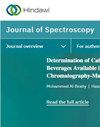Quantitative Raman Spectroscopic Determination of the Composition, Pressure, and Density of CO2-CH4 Gas Mixtures
IF 2.1
4区 化学
Q4 BIOCHEMICAL RESEARCH METHODS
引用次数: 1
Abstract
The Raman spectra for pure CO2 and CH4 gases and their ten gas mixtures were collected at pressures and temperatures ranging from 2 MPa to 40 MPa and room temperature (∼24°C) to 300°C, respectively. A systematic analysis was carried out to establish a methodology for the quantitative determination of the composition, pressure, and density of CO2-CH4 mixtures. The shift in the peak position of the υ1 band for CH4 was sufficiently large to enable the accurate determination of the pressure of pure CH4 and CH4-dominated fluids (>50 mol% CH4). An equation representing the observed relationship of the peak position of the υ1 band of CH4, density, and composition was developed to calculate the density of CO2-CH4 mixtures. The Raman quantification factor F (CH4)/F (CO2) was demonstrated to be near a constant value of 5.048 ± 0.4 and was used to determine the CH4 to CO2 molar ratio in an unknown CO2-CH4‐bearing fluid with high internal pressure (>10 MPa) based on the Raman peak area ratio. The effect of temperature on the variation in Raman spectral parameters was also investigated at temperatures up to 300°C. The results showed that the effect of temperature must be considered when Raman spectral parameters are used to calculate the pressure, density, and composition of CO2-CH4 gas mixtures. Raman spectroscopic analysis results obtained for six samples prepared in fused silica capillary capsules were validated by comparison with the results obtained from microthermometry measurements.定量拉曼光谱测定CO2-CH4气体混合物的组成、压力和密度
在2 MPa ~ 40 MPa的压力和温度范围以及室温(~ 24℃)~ 300℃的温度范围内,分别采集了纯CO2和CH4气体及其10种混合气体的拉曼光谱。为了建立定量测定CO2-CH4混合物的组成、压力和密度的方法,进行了系统的分析。CH4的峰位位移足够大,可以准确测定纯CH4和CH4为主流体(>50 mol% CH4)的压力。根据观测到的CH4的峰位、密度和组分之间的关系,建立了一个方程来计算CO2-CH4混合物的密度。拉曼定量因子F (CH4)/F (CO2)接近恒定值5.048±0.4,可用于测定未知高内压(>10 MPa)含CO2-CH4流体中CH4与CO2的摩尔比。在高达300℃的温度下,研究了温度对拉曼光谱参数变化的影响。结果表明,在利用拉曼光谱参数计算CO2-CH4混合气体的压力、密度和组成时,必须考虑温度的影响。通过与显微测温结果的比较,验证了在熔融石英毛细管胶囊中制备的6种样品的拉曼光谱分析结果。
本文章由计算机程序翻译,如有差异,请以英文原文为准。
求助全文
约1分钟内获得全文
求助全文
来源期刊

Journal of Spectroscopy
BIOCHEMICAL RESEARCH METHODS-SPECTROSCOPY
CiteScore
3.00
自引率
0.00%
发文量
37
审稿时长
15 weeks
期刊介绍:
Journal of Spectroscopy (formerly titled Spectroscopy: An International Journal) is a peer-reviewed, open access journal that publishes original research articles as well as review articles in all areas of spectroscopy.
 求助内容:
求助内容: 应助结果提醒方式:
应助结果提醒方式:


